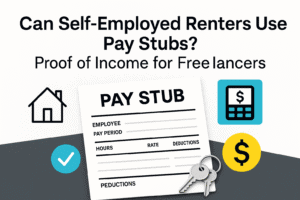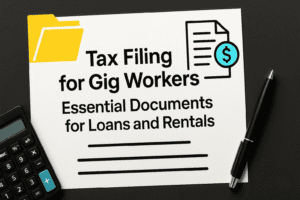Last updated: August 2025
In an ideal world, every applicant would present a neat stack of recent pay stubs. In reality, many individuals—freelancers, gig workers, new hires, tipped employees, and those paid in cash—lack conventional payroll documentation. Landlords, lenders, and agencies still need to verify income. If you’re wondering how to provide proof of income without pay stubs, this guide offers options across the United States, the United Kingdom, and Canada. We’ll walk you through assembling compliant records, permissible edits, and when professional formatting can help applications pass smoothly.
FinancialDocsProvider.com specializes in editing, organizing, and packaging existing financial documents. We transform scattered invoices, bank deposits, and tax forms into cohesive proof of earnings without altering the facts. Think of us as your administrative partner: we help you present truthful data clearly so reviewers can verify it efficiently.
Related Entities & Terms
- Pay stub / payslip / paycheck stub / remittance advice
- W‑2 and 1099 forms (US), P60/P45/SA302 (UK), T4/T4A and Notice of Assessment (NOA) (Canada)
- Gross vs net pay, year‑to‑date (YTD) totals, itemised deductions
- Employer Identification Number (EIN), Social Security Number (SSN), National Insurance (NI) number, Social Insurance Number (SIN)
- Regulators: CFPB, FTC, IRS (US); FCA, HMRC, GOV.UK (UK); FCAC, CRA, Service Canada (Canada)
- Supporting documents: bank statements, employment verification letters, client invoices, profit‑and‑loss statements
- Direct deposit, payroll providers (ADP, Paychex, Gusto), PDF/A, OCR, metadata
- Underwriting, income verification, affordability assessments and fraud detection
What are the legal basics when you don’t have pay stubs?
Summary: Most jurisdictions require employers to maintain wage records but vary on whether they must issue pay stubs. Regardless, the facts on any income document must remain unchanged. Understanding local laws helps you compile alternative proof legally.
In the United States, there is no federal law mandating employers to provide pay stubs. The Fair Labor Standards Act requires employers to keep accurate wage records but does not compel the distribution of pay stubs . Certain states mandate wage statements, while others offer electronic access. Workers without pay stubs can request payroll histories or use bank deposits, invoices, and tax returns to document earnings. Falsifying information on these records can violate state fraud statutes and federal laws.
In the United Kingdom, employers must provide payslips to every employee or worker on or before payday . The payslip must show gross pay, deductions, and net pay. Contractors and freelancers are exempt because they’re not considered employees; they issue invoices instead. Falsifying a payslip is a criminal offense under the Fraud Act 2006, and authorities cross-check payslips against bank statements and tax filings.
In Canada, most provinces require employers to issue a statement of earnings on payday. Saskatchewan’s guidelines detail typical elements: employee name, pay period dates, hours worked, pay rates, total wages, itemized deductions, and net pay . Electronic statements are permissible if employees can print copies . False statements may result in penalties under provincial Employment Standards Acts.
Even if you don’t have a pay stub, documenting your income is still required. For freelancers and gig workers, invoices, bank statements, 1099 or T4 slips, and tax returns become your proof. Our self‑employed pay stub guide explains how to consolidate these pieces into a coherent packet.

Which edits are allowed when compiling proof of income?
Summary: Edits that improve the clarity and organization of existing documents are permissible. You can redact sensitive data, merge pages, and add annotations—just don’t alter the core numbers or dates.
Reviewers seek documents that are easy to read and verify. Permitted edits focus on improving presentation, not altering content. These include:
- Redact personal identifiers. Mask your SSN, SIN, or NI number, leaving only the last few digits visible.
- Merge and reorder pages. Combine multiple screenshots or portal exports into one PDF and arrange them chronologically.
- Improve legibility. Straighten scans, enhance contrast, convert images to PDF/A, and apply OCR so text becomes searchable.
- Provide brief annotations. Include a note or summary sheet to explain one-time bonuses, overtime spikes, or irregular payments.
- Use clear file names. Rename files with a consistent naming convention like 2025‑06 Employer – Pay Statement.pdf and embed metadata that describes the source.
These edits preserve the original amounts, dates, and employer details while making the documents easier to verify. Our pay stub formatting mistakes article outlines common errors and how to correct them. For assistance with proof of income editing or bank statement formatting, our team can prepare a professional packet that complies with guidelines.
What edits are illegal and why?
Summary: Altering factual details—such as income amounts, dates, or employer names—turns a financial document into a forgery. Fraudulent documents can lead to denials, fines, or criminal charges.
Illegal edits include:
- Changing numbers. Inflating wages, adding hours, or increasing deposits to appear more creditworthy is fraud.
- Manipulating dates. Extending pay periods or changing pay dates to meet minimum requirements misrepresents your work history.
- Fabricating employers or clients. Listing companies you’ve never worked for undermines credibility and may result in criminal charges.
- Editing bank statements. Hiding overdrafts or adding fake deposits is illegal and easily detected.
- Altering tax forms. Changing figures on W‑2, 1099, P60, or T4 documents is a serious offense.
The consequences for fraudulent documents depend on your jurisdiction. In the U.S., submitting false statements to lenders may trigger fraud investigations. In the UK, forging payslips falls under the Fraud Act 2006. In Canada, document forgery is taken seriously by both employment standards agencies and criminal courts. Always provide truthful information and explain gaps or inconsistencies rather than altering records.
When do you need professional document formatting?
Summary: If you lack traditional pay stubs, professional formatting helps compile invoices, deposits, and tax forms into a cohesive packet. This is especially beneficial for renters, loan applicants, and self-employed workers.
When you lack standard pay stubs, you may face increased scrutiny. Here are situations where professional formatting can help:
Renters & housing applicants
Landlords typically ask for recent pay stubs, but they may accept alternative documentation. Provide bank statements showing rent-supporting deposits, invoices or contracts showing agreed rates and schedules, and employer or client verification letters. Pair these with tax documents (W‑2, 1099, P60, T4) to confirm your annual income. A summary sheet explaining how the pieces fit together helps landlords follow the narrative.
Car loans, mortgages & credit applications
Auto lenders and mortgage underwriters often request several months of pay records and tax returns. Self‑employed applicants should gather bank statements, a profit‑and‑loss statement summarizing revenue and expenses, and tax returns such as Form 1040 with Schedule C, SA302, or T2125. Matching deposits to invoices and reconciling totals across documents ensures consistency. Our comparison of pay stubs vs bank statements can help determine which documents to prioritize.
Self‑employed & gig workers
Freelancers, consultants, and gig workers rarely receive employer-issued stubs. Collect invoices, settlement statements from platforms, 1099 or T4A slips, and bank statements showing deposits. Summarize earnings in a profit‑and‑loss statement and include your tax returns. A cover page with a month-by-month summary ties everything together. For detailed steps, see our freelancer’s guide.
Immigration, visas & other uses
Immigration and student visa applications often require proof of income or employment. Provide employment letters, tax documents, and bank statements. When income comes from multiple sources, include a summary sheet and note currency conversions if applicable. Always confirm which documents the agency accepts before submitting.
How does FinancialDocsProvider.com help you prove income?
Summary: Our compliance-driven process turns disparate documents into a well-organized packet. We reconcile figures, apply professional formatting, and deliver reviewer-ready files without altering the facts.
When you engage our team, expect a structured workflow:
- Intake & consultation. You upload invoices, bank statements, and tax forms through our secure portal. We discuss your goal—renting, a loan, SBA, or immigration—and identify any missing pieces.
- Reconciliation & quality check. We cross-check numbers across documents and ensure totals reconcile. We’ll clarify any gaps.
- Formatting & redaction. We straighten scans, improve readability, add bookmarks and page numbers, merge files into one PDF, and redact sensitive data.
- Packaging & delivery. Turnaround is typically 24–48 hours. We provide a polished packet with a summary sheet and metadata explaining the source of each document.
- Follow-up support. We offer minor revisions at no extra cost and store your files securely for a limited period.
Our process respects your privacy, and we refuse any project that involves illegal alterations. To learn more, visit our about us page or review our service overview and pricing.
What should be in your proof‑of‑income packet?
Summary: A complete packet includes documents that show where your income originates and how it reaches your bank account. Use this checklist to audit your materials before submitting them.
For employees:
- Recent pay statements or payroll portal exports for the requested period.
- Bank statements showing employer deposits that match those statements.
- Year-end tax forms (W‑2, P60, or T4) and identification documents.
- If paid in cash, deposit slips and a letter from your employer verifying hours and pay rate.
For self-employed and gig workers:
- Invoices or settlement statements from clients or gig platforms.
- Bank statements highlighting deposits that correspond to those invoices.
- A simple profit-and-loss statement summarizing monthly revenue and expenses.
- Tax documents (1099-NEC/K, Schedule C, SA302, T2125, NOA).
- Contracts or engagement letters confirming your work arrangement.
- A cover page that lists all documents and includes a table of monthly totals.
Packaging tips:
- Submit one clearly named PDF with bookmarks separating months or document types.
- Highlight deposit amounts on bank statements and ensure they match invoice totals.
- Label files consistently and include a summary sheet to guide reviewers.
- Confirm that year-to-date totals on your documents align with tax forms; explain any differences in a note.
For more on packaging, see our in-depth guide on how to read a pay stub and our article on formatting mistakes.
What red flags cause proof‑of‑income rejections?
Summary: Incomplete, inconsistent, or poorly formatted documents are major red flags. Reviewers look for discrepancies between income sources and supporting documentation.
Avoid these mistakes:
- Mismatched totals. Deposits that don’t reconcile with invoices or pay statements.
- Missing dates or pay periods. Invoices or statements without clear start and end dates.
- Unrealistic numbers. Sudden spikes in income or hours without supporting documentation.
- Poor-quality scans. Blurry images or cropped documents that are difficult to read.
- Inconsistent styles. Mixed fonts or file types that give the documents an inauthentic appearance.
- Visible edits or erasures. Edited figures or whiteout marks suggesting tampering.
- Late tax filings. Missing or inconsistent tax returns relative to reported income.
By addressing these red flags before submission, you improve the likelihood of approval. If you’re uncertain whether something constitutes a red flag, reach out to us before submitting your documents.
Where can you find official resources and further reading?
Summary: Use official sources to verify rules and obtain forms. The links below provide authoritative guidance on pay statements and income verification in your jurisdiction.
- U.S. Department of Labor – Are pay stubs required?: Explains that the Fair Labor Standards Act requires accurate recordkeeping but does not mandate pay stub distribution .
- GOV.UK – Payslips: employee rights: Details employers’ duty to provide payslips and what must be included .
- Government of Saskatchewan – What must appear on a pay stub: Lists required elements on a Canadian statement of earnings .
- Comparison of pay stubs vs bank statements: Our blog post comparing theli>Comparison of pay stubs vs bank statements: Our blog post comparing the strengths of different income documents.
- Proof of income for freelancers guide: Our detailed guide on assembling self‑employed income packets.
- Pay stub formatting mistakes article: Learn how to avoid formatting pitfalls.
- How to read a pay stub (guide): Understand the components of a pay stub.
- For services, pricing, or to ask questions, visit our pages on financial document services, pricing, and contact our team.
Frequently Asked Questions
Provide bank statements showing consistent deposits, invoices or contracts from clients, and tax documents such as W‑2s, 1099s, T4s, or SA302 forms. A profit‑and‑loss statement summarizing your earnings and a cover letter explaining your situation also help. Professional formatting ties these pieces together.
Many landlords and lenders accept bank statements because they show actual deposits. However, bank statements don’t explain the source of each deposit. Pair them with invoices, contracts, or employment letters, and use our comparison article to decide which documents to prioritize.
Keep detailed records: request receipts, log hours worked and pay received, and deposit cash into your bank account rather than spending it immediately. Bank deposits provide a traceable record. Request a written statement from your employer confirming your pay rate and schedule and include this with your tax filings.
Requirements vary. Renters typically need two to four months of recent records. Auto lenders may ask for three to six months. Mortgage underwriters often require two years of tax returns in addition to recent bank statements. Self‑employed applicants should provide at least one year of invoices and tax documents.
Yes, when they summarize real income. A self‑employed “pay stub” is a statement of earnings derived from actual invoices and deposits. It becomes legally valid when numbers reconcile to bank statements and tax returns. See our freelancers guide for details.
Need accurate, reliable financial documents fast? Contact FinancialDocsProvider.com now.
Author: FinancialDocsProvider Editorial Team – We specialize in compliance‑first document editing and packaging for renters, loan applicants, and self‑employed individuals across the US, UK, and Canada. Learn more about us.








Add comment